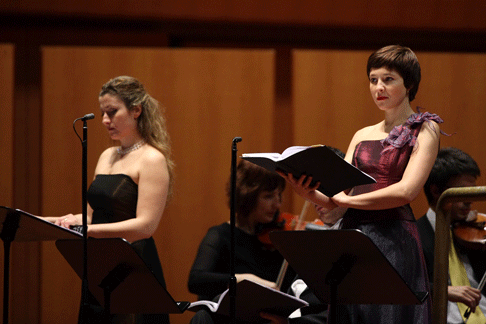Recently performed at the Accademia di Santa Cecilia in Rome (May 16-19) with an all star cast as a part of the celebration for the bicentenary of Haydn’s death. It is also the indication of revival of a nearly forgotten masterpiece: a few months ago Il ritorno di Tobia had been performed in London and Poissy under the baton of Sir Roger Norrington.
Il ritorno di Tobia had had a promising start: in April 1775 Haydn directed the first two performances of his work, written for the Vienna Tonkünstler-Societät. This success was no mere accident: Haydn had tailored his first oratorio as much as possible to suit Viennese taste. At this time Vienna was, to a certain extent, the bastion of the Italian oratorio north of the Alps. An Italian libretto was therefore indispensable, and for his subject matter, Haydn had chosen an exceptionally popular story: in the XVIII century, the Old Testament Book of Tobias was found everywhere, in painting, sculpture, literature and music; in Vienna alone it had been set to music dozens of times. Oratorios were performed in theatres because , during Lent, opera performances were forbidden; from the Playbills of the time we know that tickets for Il ritorno di Tobia were as high as those for a major opera seria performance. There was also some politics: the main theme of Il ritorno is conjugal love and parenthood; this would fit very well Empress Marie Thérèse’s view of the world- a world then rapidly changing , only a few years from Così fan tutte wives’ swapping and Marquis de Sade’s novels.
Within a short space of time copies of the score were circulating throughout Europe and Haydn himself counted the work among his most successful. It is also no surprise, however, that as early as 1781 a planned repeat performance in Vienna failed owing to the subsequent change in public taste; and besides this, as it took almost three hours to perform, the work was considered simply too long. Haydn, , was after all an experienced man of the theatre who had earned his stripes at the Esterházys’ opera house, and as such was perfectly capable of tackling the reworking of his Tobia in view of its difficulties. The parts of the Tonkünstler-Societät and Haydn’s autograph testify to this in a variety of ways: Haydn himself made alterations in a number of places in his score to passages of secco recitative, which, being accompanied only by the continuo instrument, allow the singer greater freedom in which to be creative. On the other hand, the orchestral material contains cuts in much of the extravagant coloratura, and also the repeated sections in the arias. Not only did this bring about the shortening of the work deemed necessary, it also reduced the technical demands of the arias significantly, and so made the rôles easier to cast. It is no longer possible to reconstruct beyond doubt when exactly and for which performance these alterations were made.
Even if the action is not set directly scene by scene, Il ritorno di Tobia still provides moments of striking theatricality. In matters of text setting, the Italianate oratorio of the XVIII century followed the opera seria closely: this begins with the sequence of recitatives and arias and continues with the ways in which these formal elements are given shape. The recitative is characterized from the outset by dialogue and the dramatic structure imposed by the characters’ immediate reactions to one other. This is not even altered by the fact that repeated events already bygone are brought back to life in the recitatives.

Haydn takes the opera as his model not only for the dialogical texture but also for the aria’s structure. Unlike the opera seria of the time, in which the involvement of the chorus is reserved for particularly festive types such as the Festa teatrale, in the Italianate oratorio both parts traditionally concluded with a chorus; usually the choir also played a part in the opening scene. Besides this, the inclusion of contrapuntal techniques is typical of oratorio. The basic question is still unanswered: it is an oratorio or a grand opera seria?
After performances in Vienna at the Kärtnertortheater in 1775 and in 1784 at the Hofburgtheater, where it was heard again in 1808 , Il ritorno di Tobia faded away until very recently. There only a couple of recording available - and not very easy to find and purchase.
Santa Cecilia’s lavish production is to be considered an Italian premiere. The symphony orchestra was superbly conducted by Flavio Biondi, the creator and leader of the Europa Galante ensemble. To borrow from Giuseppe Verdi one of his favorite quote Biondi “made the orchestra dance” . A few cuts were made in the very long score; I attended the Monday subscription performance starting at 9 pm. Even after the cut, the work, unknown to most of the audience, appeared too to some; at end (well after midnight) only half of the large auditorium (2800 seats) was full but those who sat through the end gave a generous applause to the orchestra, the chorus and the soloist.
The chorus deserves a special mention. There important and very difficult choral sections in Il ritorno di Tobia. They require considerable skills; conducted by Filipp Maria Bessan, the Santa Cecilia Chorus had a warm deserved applause.
Somewhat uneven the soloist cast. Maria Grazia Schiavo was an excellent Sara and gained an open stage applause after her long second act arias where her acute reached very high heights. An Allenberg is a alto specializing in baroque and XVIII century music; she was a very motherly Anne descending to very grave tonalities. Bernard Richter , Tobia,is a lyric tenor: he braved out a role requiring to climb very steep acute mountains. Less satisfactory Johannes Weisser , Tobit , and Valentina Farcas, Raffaele.
Giuseppe Pennisi

